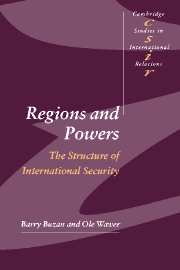Book contents
- Frontmatter
- Contents
- List of illustrations
- Preface
- List of abbreviations
- 1 Patterns of regional security during the Cold War
- 2 Patterns of regional security post-Cold War
- Part I Introduction: developing a regional approach to global security
- Part II Asia
- Part III The Middle East and Africa
- Part IV The Americas
- Introduction
- 9 North America: the sole superpower and its surroundings
- 10 South America: an under-conflictual anomaly?
- Conclusions: scenario for the RSCs of the Americas
- Part V The Europes
- Part VI Conclusions
- Glossary
- References
- News media
- Index of names
- General Index
- CAMBRIDGE STUDIES IN INTERNATIONAL RELATIONS
9 - North America: the sole superpower and its surroundings
Published online by Cambridge University Press: 05 December 2009
- Frontmatter
- Contents
- List of illustrations
- Preface
- List of abbreviations
- 1 Patterns of regional security during the Cold War
- 2 Patterns of regional security post-Cold War
- Part I Introduction: developing a regional approach to global security
- Part II Asia
- Part III The Middle East and Africa
- Part IV The Americas
- Introduction
- 9 North America: the sole superpower and its surroundings
- 10 South America: an under-conflictual anomaly?
- Conclusions: scenario for the RSCs of the Americas
- Part V The Europes
- Part VI Conclusions
- Glossary
- References
- News media
- Index of names
- General Index
- CAMBRIDGE STUDIES IN INTERNATIONAL RELATIONS
Summary
Introduction
Most books on regional security omit a chapter on North America. This might reflect American intellectual hegemony whereby ‘regional security’ comes to mean ‘all the other regions as an element in American global policy’. If regional security means ‘the rest of the world as seen from here’, ‘here’ is not a region. Furthermore, with a traditional concept of security it is not evident what should be covered under the heading of regional security in North America. Already before the Cold War it was well established that the states in the region did not fear or threaten each other in a military sense; during the Cold War their enemy was the Soviet Union, and since the end of the Cold War the most lively security debate has been in the USA, where the concerns of the official debate are located outside the region. In the field of security as elsewhere, the USA is ‘utopia achieved’ (Baudrillard 1988: 77) in the sense that the dominant IR vision in the USA right from the start has been to leave the world of security, to create in America a New World freed from the anxiety and corrupting dynamics among the states familiar from Europe. Judging from most books on regional security, this has been a success: there seem to be no such things as regional security problems in North America. We will show here what the securitisation-based story of North America looks like.
- Type
- Chapter
- Information
- Regions and PowersThe Structure of International Security, pp. 268 - 303Publisher: Cambridge University PressPrint publication year: 2003

